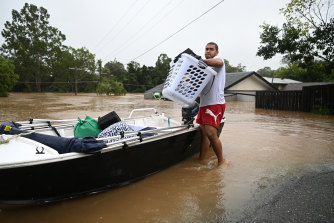Evacuations: Sometimes the real disaster is what happens after
Jane McAdam
Scientia Professor of Law
Director of Kaldor Centre for International Refugee Law at UNSW Sydney
March 22, 2022 —
The devastation caused by the recent floods in NSW and Queensland may seem a world away from the violent conflict in Ukraine, but there is a common element: the displacement of people from their homes.
In the past three weeks, more than three million people have fled Ukraine; close to two million more are displaced inside the country. Meanwhile, on Australia’s east coast, thousands of people have been left homeless as a result of the floods.

Parents accompany children and teenagers as they board a train after leaving Kyiv’s Central Children’s Hospital, following its evacuation.CREDIT:AP PHOTO
In such situations, evacuations can be a life-saving tool. Russia and Ukraine have agreed to create humanitarian corridors to enable civilians to be evacuated to safety. Whole towns in NSW and Queensland were ordered to evacuate as floodwaters rose. Though two very different contexts, the objective of evacuation is the same: to save lives and avert further harm.
Evacuations are now a major component of national and local disaster risk reduction strategies, and figures suggest that this has resulted in fewer lives being lost. In conflict, humanitarian evacuations are a life-saving measure for people facing an immediate threat of harm. Rescuing countries may initiate evacuation flights, and safe humanitarian corridors, agreed to by parties to a conflict, can enable civilians to leave as safely as possible.
In all cases, evacuations are envisaged as a temporary measure, with return home usually the ultimate goal. But far too often, situations do not resolve as anticipated. This is particularly concerning given that there were eight million evacuations from disasters globally in 2019 – a figure set to increase with the impacts of climate change.
If thought is not given to what comes next, then prolonged displacement – with its attendant economic, social and psychological impacts – may ensue. For instance, during the Second World War, 3500 British women and children were evacuated from Hong Kong to Australia, where they found themselves simply “dumped”.
Indeed, without careful planning, organisation and oversight, evacuations can themselves displace people and create other risks, including risks to life. There is mounting evidence that significant numbers of people end up displaced for long periods of time. Two years after the Australia’s 2019-20 bushfires, for instance, some people are still living in caravans, waiting to rebuild.
“People can’t move forward – they keep facing obstacles, red tape thrown up, lack of trades”, said one bushfire relief volunteer. Commonly, as the urgency of the crisis recedes, so does public awareness of their plight. In practical terms, this may mean that there insufficient support for those who are displaced, and a lack of accountability among government authorities.
Advertisement
Furthermore, even if evacuations are carried out with the best of intentions, governments must still ensure that people’s human rights are safeguarded. In Australia, current domestic frameworks pay insufficient attention to this issue. While Australian law safeguards the right to life in the emergency phase, it is otherwise silent on evacuees’ protection needs.

A man carries his belongings as people evacuate homes inundated by floodwater at Goodna in Brisbane’s west. CREDIT:GETTY
In a different context, there are myriad historical examples of long-term evacuations of children who were “rescued” then adopted out, with little regard for their right to family life (eg. British “child rescue” schemes in the 19-20th centuries; the Kindertransport in the Second World War, and Operation Babylift from Vietnam in 1975). If evacuations are seen as an end in themselves, human rights violations may be glossed over or obscured.
Despite the widespread use of evacuations in multiple contexts, there is little comparative analysis of their implementation or legal bases – a gap that my own research is starting to address.
RELATED ARTICLE

Updated
Russia-Ukraine war
Civilians flee Mariupol, Putin’s forces fire on Kyiv
Evacuations encompass an array of measures ranging across diverse international law sub-fields, including refugee law, human rights law, disaster law, humanitarian law, international criminal law, trafficking, inter-country adoption and consular protection. This wide scope means that multiple government departments and international agencies are engaged, yet typically lack co-ordination, despite common objectives and challenges.
As events in Afghanistan last year showed, evacuations can create serious security and protection concerns – both for evacuees, and for those left behind.
It is therefore imperative that protection principles, derived from international refugee, human rights and humanitarian law, are incorporated into the conception, planning and implementation of evacuations to help safeguard against such risks.
No comments:
Post a Comment